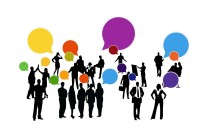- Home
- Business Processes
- Industry Knowledge
- Aerospace Industry
- Automotive Industry
- Banking Domain
- BFSI Industry
- Consumer/ FMCG Industry
- Chemicals Industry
- Engineering & Construction
- Energy Industry
- Education Domain
- Finance Domain
- Hospitality Domain
- Healthcare Industry
- Insurance Domain
- Retail Industry
- Travel and Tourism Domain
- Telecom Industry
- Leadership Skills
- eLearning
- Home
- Leadership Skills
- Communication Skills
- Guide to Receptive Listening
Guide to Receptive Listening
Listening is the foundation for good communication. It is also the hardest skill to master. Do you listen to confirm what you already know, or do you listen to explore and learn new things? How can we create receptive communication as a listener? The real art of listening involves awareness and sensitivity to the feelings of the speaker because it is at the feeling level that genuine connection, relationship, and healing occurs.
Listening involves staying focused on the speaker even if you do not like or agree with what they are saying. Effective listening also involves hearing their message and feelings of the message without formulating a response.
Is Listening Passive Activity?
Listening is often mistakenly viewed as a passive activity—the speaker talks and the listener listens. The speaker is active and verbal, and the listener is passive and silent. When the speaker finishes talking, the assumption is that the message has been accurately received by the listener, with no observable effort or participation on the listener’s part. But it’s not so simple. The assumption that the listener truly understands what the speaker has said is one of the most dangerous assumptions in communication.
Is Listening Important?
In our culture, talking is valued much more than listening. But listening is important. We cannot be successful without developing this skill. Studies show we spend 45 percent of our communication time in daily life listening, and only 30 percent speaking, 16 percent reading, and 9 percent writing. To make matters worse, studies also suggest that we remember only 25 percent of what we hear after two days. Listening is important and yet we don’t do it very well. Listening is a process that requires your active participation.
What is listening?
Listening is the process of receiving, attending, understanding, responding, and remembering. The first step in the listening process is receiving or hearing sounds from your environment. The second step is attending, which is paying attention to some of the sounds you receive and disregarding or filtering out the others. Understanding, the third step, involves comprehending the message. Responding, the fourth step includes asking questions or giving feedback to the speaker. The final step in the listening process is remembering what was said.
Types of Listening
Given below are various types of listening:
- Informative – listening for information
- Relationship- listening because it is someone you care about
- Appreciative – listening to certain people because of who they are, e.g. your manager
- Critical – listening so you can make a decision
- Discriminative – listening to the message and feelings within the message
Barriers to Listening Effectively
Highlighted below are some benefits of listening effectively:
- Achieve business goals
- Facilitate problem-solving
- Improve communication
- Improve relationships
- Avoid mistakes from misunderstandings
- Increase productivity
Common Issues with Listening
There are many different ways you can listen to another person and there is no one style of listening that creates or encourages effective, positive communication in every circumstance. The most obvious behavior that prevents effective listening is to refuse to listen to the other person. There are times when the listener attends and responds only to those subjects he is interested in and skips the rest. Listening is a difficult process. There are many barriers to listening that we experience and must contend with on a daily basis. The first barrier is the abundance of messages that bombard us every day. Preoccupation with self is the fourth barrier to listening. The final barrier to effective listening is that listening requires effort. Effective listening demands that we pay attention, process what is being said, and interact appropriately. Receptive listening ultimately requires that we put aside our ego, pay attention to what is being shared, ask questions to clarify the messages, and respond in ways that demonstrate understanding.
Effective Listening is Acceptance
The basis of all listening is an acceptance that is to be open to receive whatever the speaker is sharing with us. No receptive listening can occur without being open to the other person. Some of the barriers to effective listening discussed earlier prevent us from being receptive to what is being shared. To be truly accepted, you must be willing to put aside your thoughts, ideas, beliefs, and values for a few moments and receive what is being shared. To listen with acceptance requires that you abandon your preoccupation with yourself. Whenever a person speaks, someone else needs to listen for communication to occur. So your willingness to listen is a very important message. Don’t interrupt the speaker as he or she talks.
This article encourages participants to explore why people listen and to look at their own listening barriers that prevent them from fully listening. Participants also learn how to actively listen and to give appropriate responses. They are encouraged to use open and closed-ended questions in order to elicit more information or to confirm they understand what the speaker is saying.
Related Links
You May Also Like
-
At different points in your professional career, it is helpful to identify your core values. Values are the qualities considered to be the most important guiding principles that determine the priorities in your life and greatly influence your career choices. Your career brings happiness when it is in agreement with the beliefs you have about what is important and meaningful to you. Awareness of your values will help you develop a clearer sense of what's most important to you in life.
-
Communication performs many functions, such as informing and generating awareness, educating, persuading, motivating, entertaining, etc. The functions of communication in an organization are to inform, persuade, and motivate. Employees need to have effective organizational communication in order to achieve excellent job performance. The communication between the top management and the employee needs to be effective for better work culture.
-
This style is characterized by leaders making decisions for others and expecting followers to follow instructions. The directive leader is adept at giving instructions, setting expectations, and establishing timelines and performance standards. However, it is possible for the same leaders to display both directive and supportive behavior as per the demands of the situation.
-
Have you ever noticed how we express ourselves or interact with each other? Have you ever wondered what communication is and what role it plays in our lives? One may wonder if communication is so omnipresent and integral to our lives, why study communication at all? We need to study communication because it is a complex process that consists of many elements and is also beset with a number of barriers and there is a need to remove the barriers so that the communication process is effective.
-
Effective Business Communication
Communication is all about getting the message across correctly. To make this happen, you need to have good speaking skills and good writing skills. If you have these skills coupled with good listening skills and interest in reading, you have all the potential to be a good communicator. What things should the leader take into consideration to be more effective with interpersonal communication?
-
Listening is the foundation for good communication. It is also the hardest skill to master. Do you listen to confirm what you already know, or do you listen to explore and learn new things? How can we create receptive communication as a listener? The real art of listening involves awareness and sensitivity to the feelings of the speaker because it is at the feeling level that genuine connection, relationship, and healing occurs.
-
Process & Stages of Creativity
Creative ideas do not come just like that. There is a process to it. There are a number of techniques of creativity to support the generation of ideas but the widely practiced ones are brainstorming and lateral thinking. Most innovations are not so much the product of sudden insights as they are the result of a conscious process that often goes through multiple stages. The creative process can be divided into four stages of preparation, incubation, evaluation, and implementation.
-
Certain generally accepted truths or principles of communication are important to consider when communicating with others. These principles hold true for all people in every culture. By understanding these principles, you will experience greater communication effectiveness. An effective communication system is one that achieved its objectives. Communication is effective where there are no barriers to communication.
-
Recognizing Stress & its Sources
As an individual, you almost certainly know what stress feels like. Stressors are events or situations to which people must adjust. Stressors may be physical or psychological in nature. The level of severity of stress is determined not merely by exposure but the intensity, duration, and frequency of stressors. The sources of stress are many. They arise from multiple areas both with the individual and from the environment.
-
A manager or an employee in an organization who is experiencing a high level of stress may develop high blood pressure, ulcers, irritability, difficulty in making routine decisions, loss of appetite, accident proneness, and the like. These can be subsumed under three general categories, physiological, psychological, and behavioral symptoms. Stress can give rise to a number of changes.
Explore Our Free Training Articles or
Sign Up to Start With Our eLearning Courses

About Us
Learning
© 2023 TechnoFunc, All Rights Reserved










